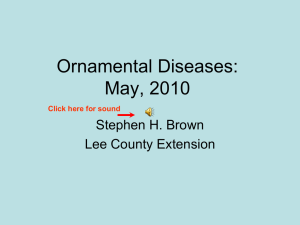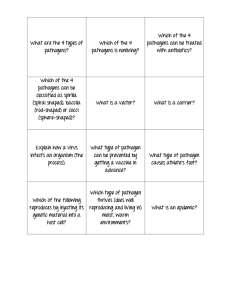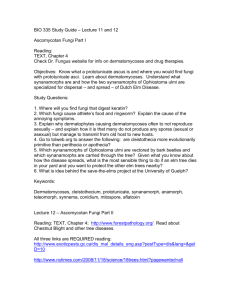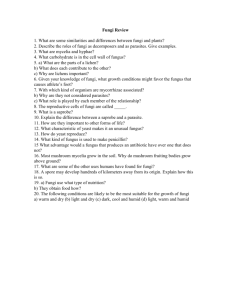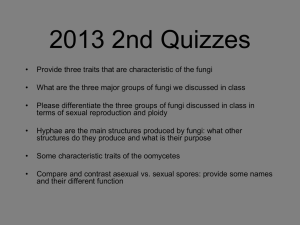2006
advertisement
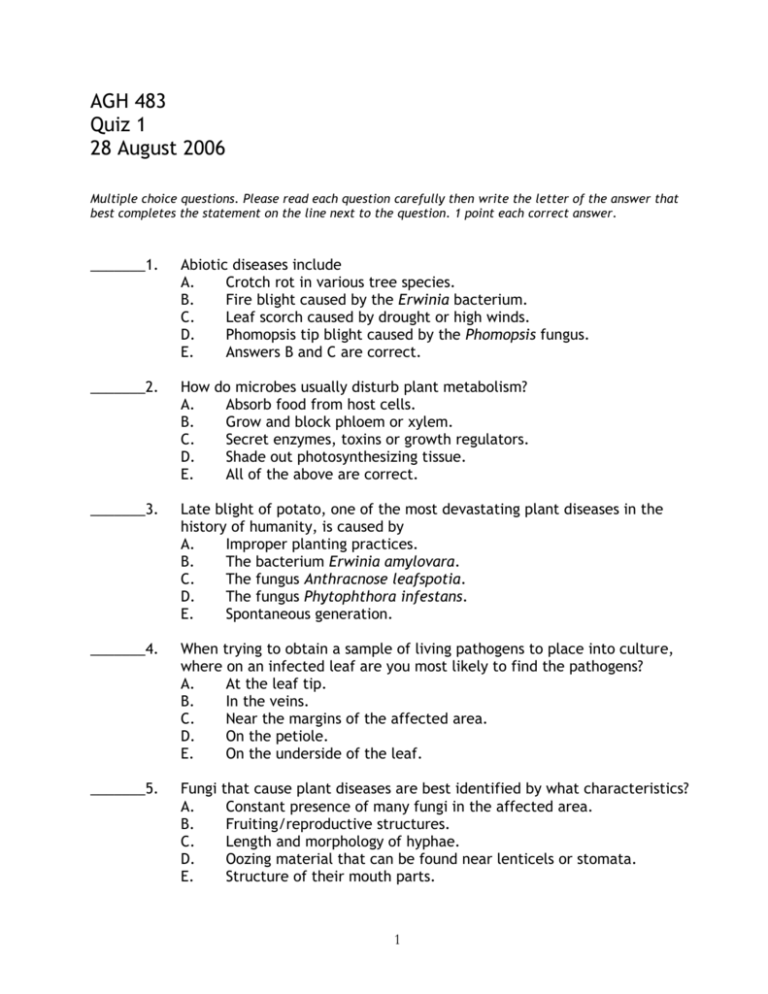
AGH 483 Quiz 1 28 August 2006 Multiple choice questions. Please read each question carefully then write the letter of the answer that best completes the statement on the line next to the question. 1 point each correct answer. _______1. Abiotic diseases include A. Crotch rot in various tree species. B. Fire blight caused by the Erwinia bacterium. C. Leaf scorch caused by drought or high winds. D. Phomopsis tip blight caused by the Phomopsis fungus. E. Answers B and C are correct. _______2. How do microbes usually disturb plant metabolism? A. Absorb food from host cells. B. Grow and block phloem or xylem. C. Secret enzymes, toxins or growth regulators. D. Shade out photosynthesizing tissue. E. All of the above are correct. _______3. Late blight of potato, one of the most devastating plant diseases in the history of humanity, is caused by A. Improper planting practices. B. The bacterium Erwinia amylovara. C. The fungus Anthracnose leafspotia. D. The fungus Phytophthora infestans. E. Spontaneous generation. _______4. When trying to obtain a sample of living pathogens to place into culture, where on an infected leaf are you most likely to find the pathogens? A. At the leaf tip. B. In the veins. C. Near the margins of the affected area. D. On the petiole. E. On the underside of the leaf. _______5. Fungi A. B. C. D. E. that cause plant diseases are best identified by what characteristics? Constant presence of many fungi in the affected area. Fruiting/reproductive structures. Length and morphology of hyphae. Oozing material that can be found near lenticels or stomata. Structure of their mouth parts. 1 _______6. Which of the following disease categories is considered the most useful? A. Plant organ the disease affects. B. Symptoms the disease causes. C. Time of year the disease occurs. D. Type of pathogen. E. Types of plants affected. _______7. If oak trees begin to show disease symptoms because they were attacked by a vascular fungal pathogen, this is an example of A. Abiotic Disease Factors. B. Biotic Disease Factors. C. Symbiotic Disease Factors. D. Answers A and B are true. E. All of the above are true. Short answer. Give a brief definition or answer in the space below the question. 1 point each correct answer. 8. What is a mycotoxin? 9. What is an aflatoxin? 10. List at least three disease symptoms (eg: canker). 2 AGH 483 Quiz 2 6 September 2006 Multiple choice questions. Please read each question carefully then circle the letter of the answer that best completes the statement. Each question is worth 1 point. ______1. A pathogen is A. Always insect-vectored. B. Microbe, insect or environmental factor that causes disease. C. Organism that removes nutrients and water from its host. D. All of the above are true. ______2. Signs of a disease include A. Bleaching of wood caused by white rot fungi. B. Galls produced on junipers infected by Apple Cedar Rust. C. Water-soaked spots on ivy leaves. D. Both B and C are correct. ______3. If a row of shrubs begin to show disease symptoms because the soil was flooded, this is an example of A. Abiotic Disease Factors. B. Biotic Disease Factors. C. Symbiotic Disease Factors. D. None of the above is true. ______4. An antagonistic microorganism A. Attacks and injures plants. B. Attacks or repels plant pathogens. C. Attacks the farmers tending the crops. D. All of the above may be true. ______5. The fungus that causes late blight of potato, one of the most devastating plant diseases in the history of humanity, is A. Anthracnose leafspotia. B. Erwinia amylovara. C. Phytophthora infestans. D. Late blight of potato was caused by improper planting practices, not a fungus. 3 True/false questions. Please read each statement carefully then on the line next to the statement place a T if the statement is true or an F if the statement is false. Each question is worth 1 point. ______6. Inoculation ≠ infection. ______7. Penetration = infection. ______8. Obligate parasites require a living host for growth and reproduction. ______9. Viruses are always spread by insect vectors. ______10. Ooze is a symptom or sign caused when a plant is infected with a certain group of fungal pathogens. 4 AGH 483 Quiz 3 13 September 2006 Multiple choice. Read the question carefully, and then write the letter of the correct answer in the line next to the question. (1 point each correct answer) _______1. Pectinase, an enzyme produced by pathogens, breaks down this substance or structure in plants. A. Cell membranes. B. Cutin. C. Glucose. D. Middle lamella. E. Plasmodesmata. _______2. Microbial toxins are extremely poisonous substances that are effective in low concentrations. The effect of the toxins includes A. Altering cell membrane permeability. B. Deactivating or inhibiting plant enzymes. C. Formation of an appressorium and penetration peg. D. All of the above are true. E. Only answers A and B are true. Circle the correct answer among the choices in bold type. (worth 1 point and you must correctly answer all segments to get credit for this question) 3. Cutinase is produced by pathogens/plants. Cutinase forms/breaks cutin molecules. Glucose/pectinose suppresses the production of cutinase. True or false. Read each question carefully, then print a T on the line next to the question if the statement is true, or an F on the line if the statement is false. (1 point each correct answer) _______4. Penetration = infection. _______5. Bacteria may penetrate plant surfaces by forming an appressorium and penetration peg. _______6. Mechanical weapons are the most common method of attack by pathogens. Short answer. Please read the questions carefully before writing your answers.(1 point each correct answer) 7. Pathogens use two main methods, or weapons, to attack plants: mechanical forces and chemical forces. 5 a. Give an example of mechanical forces exerted by pathogens on host tissues. b. Give an example of chemical forces exerted by pathogens on host tissues. 8. Diseases can have a major impact on plant physiological functions. a. Describe two specific ways pathogens can impair photosynthesis. b. Describe two specific ways pathogens can impair translocation in plants. 6 AGH 483 Quiz 4 25 September 2006 Matching. Place the letter of the phrase that best matches the description in the space next to the description. Phrases may be used more than once or not at all. A. B. C. D. E. F. G. Apparent resistance Gene-for-gene concept Horizontal resistance Horizontal and vertical resistance Tolerance True resistance Vertical resistance ______1. Changes in the virulence of a pathogen appear to be continually balanced by changes in the resistance of the host, and vice versa. ______2. Plant does not develop disease from a soilborne pathogen because the seeds germinate before the temperature becomes favorable for the pathogen to attack. ______3. A lower level of resistance to any specific race of pathogen but effective against a larger number of pathogens. ______4. A plant escapes or tolerates a disease. [Do not answer B or E] ______5. Breeding program incorporates one or a few resistance genes that control important steps in disease development or resistance. ______6. This type of genetic resistance usually makes plants resistant to a greater number of pathogen species. ______7. Tomato plant develops necrotic spots on foliage and some yellowing but still produces acceptable crop. 7 True/false questions. Please read each statement carefully then on the line next to the statement place a T if the statement is true or an F if the statement is false. Each question is worth ½ point. ______8. Diseases typically cause an increase in transpiration. ______9. Phenolics inhibit enzymes that pathogens use to break down pectin. ______10. Saponins are chemicals produced by plants to break down fungal cell membranes. ______11. Lignin and suberin are phenolic compounds. 8 AGH 483 Quiz 5 3 October 2006 Short answer. 1 point each 1. What conditions led to the development of an epidemic of late blight on potatoes in Europe beginning in 1845? 2. What conditions led to the development of the famine in Ireland beginning in 1845? 3. What can be done to prevent a similar tragedy from occurring in the future? 4. Why does the detection of the A2 strain of Phytophthora infestans pose new problems for managing late blight of potato? 5. Where did the pathogen that causes late blight of potato originate? 6. What was the route of spread from there to Europe? 7. List two ways to exclude pathogens from host plants. 8. Name an epidemic caused by an introduced pathogen. 9. What is the difference between infestation and infection? 10. Where on a plant might it be most likely to be free of a systemic infection? 11. List one other key fact about late blight of potato and the potato famine in Ireland that was not asked on this quiz. 9 AGH 483 Quiz 6 11 October 2006 write your name on the back of the quiz, please Fill in the blanks to complete the outline. 1 point each Disease Control Methods I. Exclude Pathogen from Host 1. ___________________________________________ 2. Evasion or Avoidance – Example: __________________________________________ 3. Pathogen-Free Propagules – Example: Certified Disease-Free Seeds or Cuttings 4. II. Coat Epidermis to Exclude Pathogen ________________________________________________________ 1. Cultural Methods – Example: __________________________________________ – Example: __________________________________________ 2. __________________________________________________ 3. Physical Methods – Example: __________________________________________ 4. III. Chemicals Immunize or Improve Resistance 1. Cross Protection – Example: Protect a Plant by Infecting It with Mild Strain of a Severe Virus 2. Induced Resistance: Systemic Acquired Resistance 3. Plant Defense Activators – Example: __________________________________________ 4. Improved Growing Conditions – Example: __________________________________________ 5. IV. Use of _________________________________________ Use Direct Protection Methods – Example: __________________________________________ 10 AGH 483 Quiz 7 18 October 2006 Multiple choice. Read the question carefully, and then write the letter of the correct answer in the line next to the question. (1 point each correct answer) ______1. The filamentous body of a fungus is called A. Apothecium. B. Conidium. C. Haustorium. D. Meiosporium. E. Mycelium. F. Sporangium. ______2. The feeding structure a fungus sends into plant cells is called A. Apothecium. B. Conidium. C. Haustorium. D. Meiosporium. E. Mycelium. F. Sporangium. ______3. The overwintering structure of a fungus is called A. Conidium. B. Haustorium. C. Majorsporium. D. Mycelium. E. Sclerotium. F. Zoosporangium. ______4. While most fungi are spread by passive methods, some forcibly discharge their spores into the environment. This method is known as A. Oozing. B. Puffing. C. Sclerifying. D. Sneezing. E. Snoozing. F. Sporotizing. ______5. These are the club and mushroom fungi. A. Ascomycota. B. Basidiomycota. C. Chytridiomycota. D. Oomycota. E. Zygomycota. F. All of the above are club and mushroom fungi. 11 ______6. The most common disease found in turfgrass in Southwest Missouri, according to Ryan Law and Tree’s Turf Manager Mark Ricket. A. Brown patch. B. Dollar spot. C. Fairy ring. D. Pythium blight. E. Smut. F. Spring dead spot. ______7. The turfgrass disease that golf course superintendents fear the most, according to Ryan Law and Tree’s Turf Manager Mark Ricket. A. Brown patch. B. Dollar spot. C. Fairy ring. D. Pythium blight. E. Smut. F. Spring dead spot. ______8. Most of the turfgrass diseases seem to occur during these environmental conditions. A. Cool and dry. B. Cool and wet. C. Cool, dry and sunny. D. Warm and dry. E. Warm and wet. F. Warm, dry and shady. ______9. Most of the turfgrass diseases are caused by this kind of pathogen. A. Bacterium. B. Fungus. C. Nematode. D. Parasitic plants. E. Squirrel. F. Virus. Short answer. Turfgrasses seem to be susceptible to many diseases, in large part because the grass plants are stressed in lawn and golf course environments. List at least three of the stress factors. (2 points) 12 AGH 483 Quiz 8 25 October 2006 Multiple choice. Read the question carefully, and then write the letter of the correct answer in the line next to the question. (1 point each correct answer) ______10. These are the sac or cup fungi. A. Ascomycota. B. Basidiomycota. C. Chytridiomycota. D. Ergomycota. E. Oomycota. F. Zygomycota. ______11. This is a common fungal cause of hay fever. A. Alternaria. B. Claviceps. C. Erwinia. D. Fusarium. E. Phytophthora. F. Taphrina. ______12. Which is considered the best control method for sooty mold? A. Contact fungicide. B. Controlling the humidity and temperature. C. Crop rotation. D. Systemic fungicide. E. Resistant varieties. F. None of the above is true. ______13. Fungi that cause these two diseases produce a mycotoxin. A. Botrytis and Anthracnose. B. Botrytis and Apple-Cedar Rust. C. Botrytis and Pythium Blight. D. Ergot and Alternaria Leaf Spot. E. Ergot and Pythium Blight. F. Ergot and Sooty Mold. ______14. This disease could be controlled with a single fungicide application early in the spring. A. Alternaria Leaf Spot. B. Cedar-Apple Rust. C. Fusarium Wilt. D. Late Blight of Potato. E. Sooty Mold. F. Taphrina Leaf Curl. 13 ______15. This fungal genus is responsible for Ergot diseases. A. Alternaria. B. Claviceps. C. Erwinia. D. Fusarium. E. Phytophthora. F. Taphrina. ______16. These are among the fungi that cause wilt diseases. A. Botrytis. B. Erwinia. C. Fusarium. D. Phytophthora. E. Taphrina. F. Ustilago. ______17. This disease is known as gray mold. A. Alternaria Leaf Spot. B. Anthracnose. C. Botrytis. D. Fusarium Wilt. E. Pythium Blight. F. Rhizopus Soft Rot. ______18. These disease organisms typically have five different fruiting structures and five types of spores in sequence. A. Ergot fungi. B. Phytophthora fungi. C. Pythium Blight fungi. D. Rust fungi. E. Soft rot bacteria. F. Soft Rot fungi. ______19. As a general rule, this is considered the best single method to control fungal diseases. A. Antagonistic microbes. B. Control of insect vectors. C. Crop rotation. D. Cultural controls. E. Fungicides. F. Resistant varieties. ______20. Fungi responsible for this disease are able to attack hosts by secreting pectinase and cellulase. A. Alternaria Leaf Spot. B. Botrytis Blight. C. Cedar-Apple Rust. D. Rhizopus Soft Rot. E. Sooty Mold. F. Taphrina Leaf Curl. 14 AGH 483 Quiz 9 1 November 2006 Short answer. 1. Draw and correctly label a typical bacterium. For full credit, seven structure/substances should be included. 7 points 2. Name two genera of plant pathogenic bacteria. 1 point 3. Name a type of enzyme or other compound secreted by bacterial pathogens to help them obtain nutrients from the plant and neutralize the plant's defense responses. 1 point 4. ___________________________________ gene transfer is the process in which an organism transfers genetic material to another cell that is not its offspring. 1 point 5. Bacteria are able to communicate with each other via chemical signals. One of the results of this communication, according to research conducted in the lab of Bonnie Bassler at Princeton University, is a blue glow produced by luminescent marine bacteria. What is another result of the communication? 1 point 6. These two plant organelles are believed to be descendents of ancient free-living bacteria. 1 point 15 AGH 483 Quiz 10 29 November 2006 Answer any 10 of the following questions. Answer only 10 of them! The first 10 with answers are the 10 that will be graded. If you answer a question but change your mind and do not want it graded, mark the question and the answer out completely. 1 point each Multiple choice. Please read the question carefully then write the letter of the answer that best completes the statement on the line in front of the question. ______1. Grapes from this country are resistant to many diseases and are commonly used as rootstock for grape plants worldwide. A. Australia. B. France. C. Italy. D. Somalia. E. United States. ______2. A plasmid is A. A mobile chromosome. B. Used to transfer resistance genes from one bacterium to another. C. Important in genetic engineering. D. All of the above are true. E. None of the above is true. ______3. A. tumefaciens forces plant cells to produce an unusual compound that can be used as food if an organism possesses certain enzymes to break down the compound. Only the same bacterial strain that induced the plant to produce the compound possesses those enzymes. This compound is A. Agrocin 84. B. Cytokinins. C. ELISA. D. Opines. E. None of the above is true. ______4. Tomato Spotted Wilt Virus, which causes diseases on more than 500 species of plants, is vectored by this insect, and can actually replicate inside the vector’s body during certain life stages of the insect. A. Aphid. B. Flea. C. Leafhopper. D. Mealybug. 16 ______5. E. Thrips. This was the first successful biological control organism used to prevent a plant disease. A. Agrobacterium radiobacter. B. Agrobacterium tumefaciens. C. TSWV bio-indexing. D. Xylella fastidiosa. E. None of the above is true. ______6. This condition is required for Agrobacterium tumefaciens to infect a plant. A. Healing. B. Soil temperatures between 45° and 55° F. C. Wounding. D. All of the above are true. E. None of the above is true. ______7. The MSU Fruit Science Research Center at Mountain Grove uses this technique to eliminate viruses in grape plants. A. Electrophoresis. B. Heat treatment. C. Tissue culture. D. Answers B and C are true. E. All of the above are true. ______8. These are the two most common foliar diseases of tomatoes. A. Alternaria Leaf Spot and Verticillium Wilt. B. Anthracnose and Cercospora Leaf Spot. C. Anthracnose and Fusarium Wilt. D. Early Blight and Septoria Leaf Spot. E. Late Blight and Botrytis. ______9. Blossom End Rot of tomatoes is caused by a A. Bacterium. B. Calcium deficiency. C. Fungus. D. Sun scald problem. E. Answers A and B are true. ______10. Tomatoes are very sensitive to juglone, the allelopathic compound produced by walnut trees. Symptoms on tomatoes when they are reacting to the juglone include A. Blackened stems. B. Excessively large fruit. C. Leaf blight. D. Wilt. E. None of the above is true. 17 True or false. Read the question carefully, and then place a T in the space next to the statement if it is true. Place an F in the space next to the statement if it is false. ______11. The virulence region of Agrobacterium tumefaciens’ chromosomes can be removed and replaced with other genes. ______12. Sometimes a plant is suspected of having a viral infection but has no symptoms of infection. Using sap from the suspicious plant, scientists can inoculate plants that are susceptible to most viruses (and readily show symptoms when they become infected). This procedure is known as bio-indexing. ______13. ELISA is a nucleic acid-based bioassay while PCR is protein-based. ______14. If a plant is infected with a virus, a viral protein called an antigen will be present in the plant sap. ______15. Antibodies are a type of protein. They are produced by a mammal’s immune system in response to foreign substances that may be a threat to the body. 18
